|
August 17, 2007
We got a very early start to get to Cairns for our appointment to get our fridge worked on. The drive took us over the coastal mountains back through Mossman and Port Douglas and then down the beautiful Cook Highway back to Cairns. We spent the day parked at the repair shop where Andy (the business' owner) personally did the work. The consensus was that the compressor on the fridge did not have the proper charge of gas to adequately cool the unit. Since the compressor is not designed to be worked on in the field, the first thing needed was to weld on a valve so that the gas could be drained, then recharged. All went very smoothly and we were able to leave with enough time to drive ourselves back up onto the Atherton Tableland, do some grocery shopping and find a free camp spot in Mareeba.
August 18, 2007
First thing in the morning we found a wifi spot at a fish and chips restaurant, so we did some internet work and made some Skype phone calls. We then headed a short way out of town to camp once again at the Rocky Creek War Memorial as we knew it had a large enough space that we could empty our storage boxes and clean out the dust from our Cape York Expedition. It looks like the weather stripping we added worked well, so now we can venture further on roads with powdery bull dust and not worry about too much dust penetration. The bull dust is fine like talcum powder so it is really nasty stuff.
August 19 - 21, 2007
| After our clean up, we finally headed west on the Savannah Way. The Aussies like to name the major roads across the country, so we'll be coming across more of them. We'll be taking this road across to Karumba on the Bay of Carpentaria. Like the name implies, the scenery that we drove through for three days conjured up visions of African savannah - tall grasses and graceful spreading trees. It was also very dry, but we did see the occasional pond filled with water lilies and birds. The road itself was challenging. It is paved, but only one lane wide. So we had to keep a keen watch for on-coming traffic, and every time a vehicle approached, we would both have to pull half onto the dirt shoulder to pass. But when a roadtrain approached, WE would be the one to pull completely off the road and out of its way! |
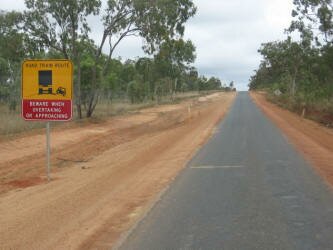
|
|
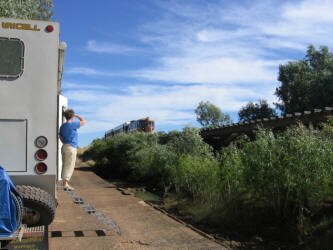
|
We found a couple of great free camping spots in the bush, one of which was on a low water crossing bridge on the Norman river between the highway bridge and the railroad bridge. This was a terrific spot with good hiking and bird watching opportunities. Also in the morning we were treated to the two car Gulflander train coming by and everyone on the train waving at us. The Gulflander line was built in 1887 to move ore from first the copper fields and then the gold fields. It is currently used as a tourist train, running between Normanton and Croydon and today it was on a special chartered run.
|
We stopped in Normanton and visited the historic train station with its museum and it's two Brolga cranes that have been in residence at the station for over ten years. We also passed by the model of a crocodile (shot by a local resident) that was a record-breaking 28 feet long! It really looked prehistoric!
We then continued on to Karumba which is on the coast of the Bay of Carpentaria, passing many more Brolga and Sarus cranes. We found an interesting camp spot just above the mud flats and mangroves north of town and spent the afternoon hiking over the interesting rock formations and bird and kangaroo watching. Oh yeah, and watching the airplanes take off and land as we were just past the airport. We also noticed that the tide went out an incredible distance. When it was completely out, you almost couldn't see the water.
August 22, 2007
In the morning, the tide was in but it never got completely into the mud flats we were parked above. This made for an interesting area to watch the fish that seemed to live partly in and partly out of the water. These small fish would actually crawl out of the water and scuttle across the mud to another water puddle! We left late morning and drove west all afternoon, stopping at an unused construction pit east of the Burke and Wells Roadhouse. It was a great spot, flat and out of sight of the road, but the flies were terrible and we used our fly nets for the first time. The fly nets fit over our hats and keep the flies off of our faces
August 23, 2007
In the morning we drove from our construction pit camp site to the Burke and Wills Roadhouse where we got advice on the roads ahead. All the roads sounded fine, we just needed to pay attention and watch for cows and road trains. The owner of the roadhouse informed us that the number of cows hit on the road over the previous year had totaled 170. At first we were skeptical but after driving for a hour or so, we saw so many dead cows that we figured the number was accurate.
|
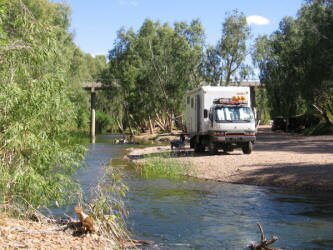
|
While we were at the roadhouse, we met another couple who were touring the area, and they told us about a nice free camping spot on the Gregory River in Gregory Downs. Since we were on our way to Boodjamulla National Park, we figured we would stop at the river for lunch. But when we arrived, we were so impressed by the beauty of the location that we decided to spend the afternoon and night. The location is under the highway bridge that crosses the river (it isn't as bad as it sounds, there is very little traffic). Access was easy and there were lots of other campers there. It is a very popular spot because you can park right at the edge of a beautiful rushing river. After finding a spot, we set up our chairs and spent the afternoon bird watching and talking to the other campers. |
August 24, 2007
After enjoying the morning at our beautiful site, we drove from Gregory Downs to Boodjamulla National Park (which used to be known as Lawn Hill National Park). As advised, the dirt road wasn't too bad and even the road trains made themselves scarce (we only saw one). Along the drive we could see some of the interesting landscape that makes the park unique. The hard sandstone was originally a blanket of sand deposited in an ancient seabed about 1560 million years ago. Ripple marks from it are still visible in it.
As soon as we arrived at the park, we decided to put up our screen tent for the first time since Belize. The flies weren't as bad as at the construction pit, but they were annoying enough and we figured the mosquitoes would be out later.
| After lunch we got our bicycles off their rack, cleaned the dust off of them and went for a ride on the trails in the park. The park is beautiful and one of the trails led to some Aboriginal rock art by the Waanyi people. The art included two yellow rainbow shaped figures and lots of pecked circles. There were also trails to some cascades on the creek and to the lower gorge where we were supposed to be able to see crocodiles. But our luck remained the same and we saw... none! |
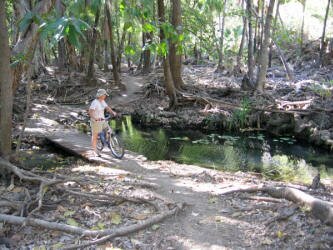
|
August 25, 2007
|
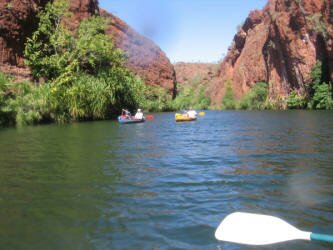
|
In the morning we took out our kayak and went boating on Lawn Hill Creek. This is another slow moving river, fed by springs and we were able to paddle easily in both directions. First we headed up river through the upper gorge toward Indarri Falls. The sheer red walls of the gorge were beautiful and we saw lots of ferns growing out of the walls. When we got close to the falls, we were able to kayak almost all the way up to them. The falls are made of a material called tufa which is a porous rock composed primarily of calcium carbonate which gradually builds up to form dams. Interestingly, if you were to drink the water in the creek, the calcium carbonate would actually serve to make you thirstier!
We were able to portage the kayak around the falls, and continued a ways further upstream. When we reached the end of the paddle-able area, we beached the kayak, jumped in the water and went for a swim.
|
August 26, 2007
We spent a good portion of the morning packing up all the stuff we had taken out. That took a while, but we finally got on the road by 10:30am. We drove from Boodjamulla to Riversleigh, which is another part of the National Park. It is a World Heritage Site featuring fossils and is considered among the richest and most extensive deposits in the world. The fossils date back 25 million years to the Oligocene period. Turtles, fish, snails, crocodiles, lizards, pythons, birds and kangaroos have all been found here, but, unfortunately the part of the site that you can visit is very small and the fossils you can view very limited. It takes quite a bit of imagination when looking at a small fossilized bone fragment to say "hey, so is that a ???".
We continued down the road which alternated from being pretty good to pretty bad. A nice highlight were the three water crossings that we had to make, even though the water was only about six inches deep. We finally hit pavement late in the afternoon and drove to the main highway where we spent the night at a rest stop.
|